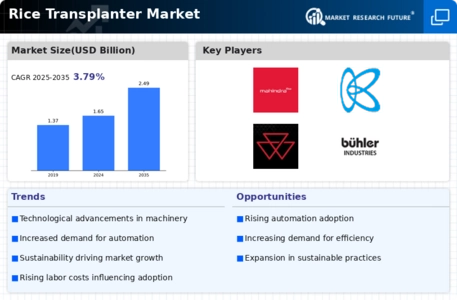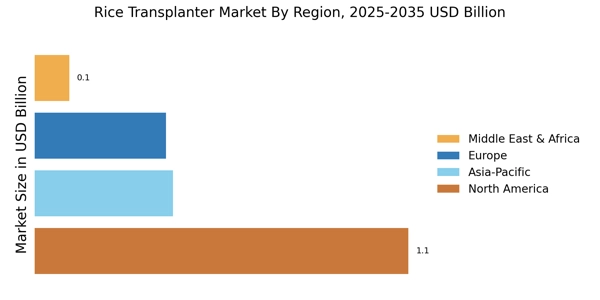Sustainability Focus in Rice Transplanter Market
Sustainability has become a pivotal driver in the Rice Transplanter Market, as consumers and governments alike emphasize environmentally friendly practices. The demand for sustainable agricultural methods is prompting manufacturers to develop transplanters that minimize soil disturbance and reduce chemical usage. This shift is reflected in the increasing market share of eco-friendly transplanters, which are designed to optimize resource use and enhance soil health. Recent statistics indicate that sustainable practices in rice farming can lead to a 30% reduction in water usage. As awareness of environmental issues grows, the Rice Transplanter Market is likely to see a surge in demand for products that align with sustainable agricultural practices.
Technological Advancements in Rice Transplanter Market
The Rice Transplanter Market is experiencing a notable transformation due to rapid technological advancements. Innovations such as GPS-guided systems and automated planting mechanisms are enhancing efficiency and precision in rice cultivation. These technologies not only reduce labor costs but also improve crop yields, which is crucial in meeting the increasing global food demand. According to recent data, the adoption of advanced transplanters has led to a 20% increase in planting efficiency. Furthermore, the integration of IoT devices allows for real-time monitoring of soil conditions, enabling farmers to make informed decisions. This trend towards modernization is likely to drive the Rice Transplanter Market forward, as more farmers seek to adopt these technologies to remain competitive.
Shift Towards Mechanization in Rice Transplanter Market
The Rice Transplanter Market is witnessing a significant shift towards mechanization, driven by the need for increased productivity and efficiency in rice farming. As labor shortages become more prevalent, farmers are increasingly turning to mechanized solutions to ensure timely planting and harvesting. This trend is supported by data indicating that mechanized transplanters can reduce planting time by up to 50%, allowing farmers to cover larger areas in shorter periods. Additionally, mechanization helps in minimizing human error and improving planting accuracy, which is essential for maximizing yields. Consequently, the Rice Transplanter Market is likely to expand as more farmers invest in mechanized equipment to enhance their operational capabilities.
Government Initiatives Supporting Rice Transplanter Market
Government initiatives play a crucial role in shaping the Rice Transplanter Market, as various policies and subsidies are introduced to promote modern agricultural practices. Many governments are recognizing the importance of mechanization in enhancing food security and are providing financial assistance to farmers for purchasing transplanters. For instance, recent programs have allocated significant funds to support the acquisition of advanced planting equipment, which is expected to boost the market. Furthermore, educational campaigns aimed at demonstrating the benefits of mechanized planting are likely to increase adoption rates among farmers. As these initiatives continue to evolve, the Rice Transplanter Market is poised for growth, driven by enhanced accessibility to modern technologies.
Rising Demand for High-Yield Varieties in Rice Transplanter Market
The increasing demand for high-yield rice varieties is significantly influencing the Rice Transplanter Market. As populations grow and food security becomes a pressing concern, farmers are seeking ways to maximize their output. High-yield varieties require precise planting techniques to ensure optimal growth, which in turn drives the need for advanced transplanters. Recent studies suggest that the use of specialized transplanters can enhance the performance of these varieties, leading to yield increases of up to 25%. This trend indicates a strong correlation between the adoption of high-yield rice varieties and the growth of the Rice Transplanter Market, as farmers invest in equipment that supports their agricultural goals.


















Leave a Comment